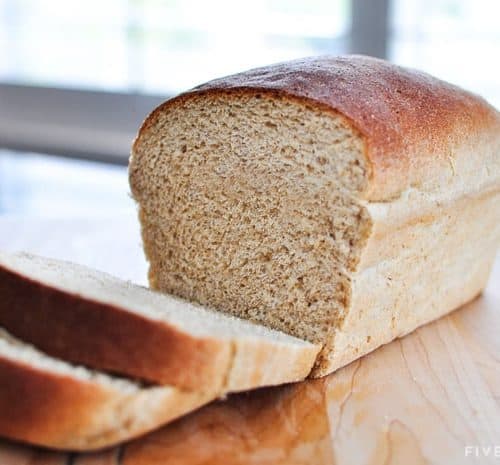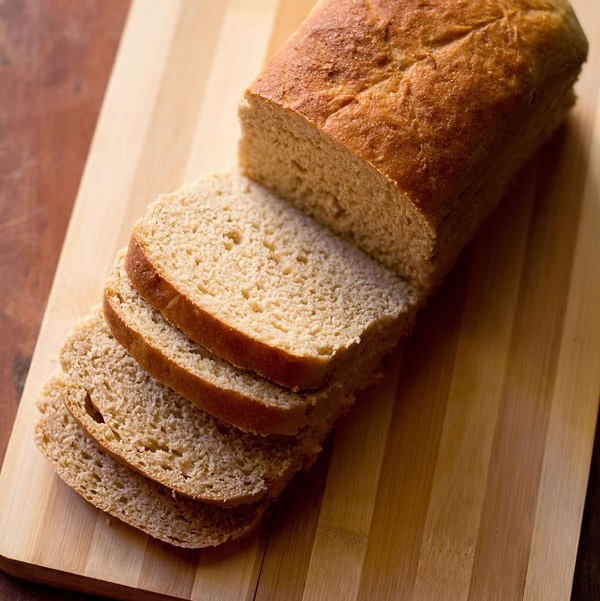Whole Wheat Bread Nutrition Facts and Health Benefits
With the rise of low-carb and gluten-free eating plans, bread’s reputation has taken a serious hit in recent years. And while it’s true that nutritional value does vary from brand to brand and recipe to recipe, there’s one kind of bread that’s generally a nutritious and versatile addition to a healthy diet: whole wheat.
The USDA encourages making half your grains whole, and whole wheat bread falls squarely into this category. So what is it that makes whole wheat healthier than white (or “refined grain”) bread? Whole wheat bread is made from flour that contains the entire wheat kernel, including the bran and germ. It’s here that wheat packs the most nutrients, such as fiber, B vitamins, iron, folate, potassium, and magnesium. Leaving the wheat kernel intact makes for a less processed, more nutritious bread.
While a small percentage of the population may need to avoid bread due to health conditions, eating whole wheat bread has been associated with a number of health benefits. For most people, it’s an excellent choice for boosting whole grain intake.
Whole Wheat Bread Nutrition Facts

The following nutrition information for one slice (43g) of whole wheat bread has been provided by the USDA.
- Calories: 80
- Fat: 0g
- Sodium: 170mg
- Carbohydrates: 20g
- Fiber: 3g
- Sugars: 4g
- Protein: 5g
Carbs
Whole wheat bread is loaded with complex carbohydrates—the kind that keep you fuller longer. An average slice contains anywhere from about 12 to 20 grams of total carbohydrates, a significant amount of which are fiber (3 grams per slice).
Some whole wheat breads may have additional carbs from added sugars. Stay informed about what you’re getting by looking at the “Added Sugars” line of a nutrition facts label.
Fats
Unless whole wheat bread is made with added oil, it contains no fat. Again, check ingredient labels to see if oils have been used in store-bought bread.
Protein
Whole wheat isn’t just a good source of complex carbs—it’s also surprisingly high in plant-based protein. A single slice of whole wheat bread can contain up to 5 grams of protein.
Vitamins and Minerals
The vitamins and minerals in whole wheat bread can vary widely, depending on what a manufacturer chooses to add through enrichment and/or fortification. Most whole wheat breads contain small amounts (under 10% RDI) of iron, potassium, and B vitamins thiamin, riboflavin, niacin, and folate. If a recipe includes salt, the bread will also contain sodium.
Health Benefits
Whole wheat bread offers a number of benefits from its whole grain content to its effects on weight.
Promotes healthy digestion

Fiber is a critical nutrient for digestive health—and not just to help you go to the bathroom regularly. Consuming plenty of fiber through whole grain foods paves the way for healthy gut bacteria to thrive. This so-called “pre-biotic” effect has been found to boost colonic health and fortify the immune system.1
Boosts heart health

Whole grains have long been touted for heart health, for good reason. A landmark 2016 study in the British Medical Journal revealed that eating more whole grains was associated with significantly reduced risk of cardiovascular disease and coronary heart disease.2
May lower the risk of stroke
The same BMJ study that linked eating whole grains to a healthier heart also connected them to a lower risk of stroke. And that’s not all! The study even showed that death by any cause fell with an increase in whole grain consumption.
Reduces the risk of type 2 diabetes
Research also has good news for those at risk of developing type 2 diabetes. A 2018 review in the journal Nutrients concluded that studies have “consistently demonstrated” that a higher intake whole grain foods is associated with lower risk of type 2 diabetes.
Helps with weight management
Despite bread’s reputation of adding to your waistline, choosing whole wheat may have the opposite effect. A review that compiled data from 38 epidemiological studies revealed that eating whole wheat bread did not cause weight gain and might even be beneficial for weight management.
Allergies
While people with a wheat allergy sometimes have to do some digging to determine the safety of certain foods, whole wheat bread is very clearly a no-no. If you have a wheat allergy, you’ll need to steer clear of not only whole wheat bread itself, but also any of its byproducts, such as bread crumbs.
Still craving a chewy sandwich base? You can always explore alternative types of bread, such as those made with 100% rye, pumpernickel, or oats. With these stand-ins, you’ll reap the benefits of eating whole grains, without the risk of an allergic reaction.
Adverse Effects
People who need a low-fiber or low-carbohydrate diet may need to limit whole wheat bread. While it is by no means an unhealthy food, it may not be compatible with these special diets, especially in large quantities. People with celiac disease or non-celiac gluten sensitivity will also need to keep whole wheat bread off the menu, since wheat contains gluten.
Varieties
While browsing the bread aisle, you may have wondered: What’s the difference between whole wheat and whole grain? Breads labeled as whole grain may contain other grains besides wheat (such as millet, oats, or barley), while breads labeled as whole wheat are made with just wheat grains.
And what about white whole wheat bread? This lighter-colored bread is still made with the intact wheat kernel—it’s just a different variety of wheat than traditional whole wheat bread.
Storage and Food Safety
The countertop or bread box are generally safe places to store purchased whole wheat bread, as it’s intended to be shelf-stable. At room temperature, whole wheat bread should last anywhere from four days to a week. However, some breads with fewer preservatives (including homemade whole wheat bread) may do better in the refrigerator, especially if you don’t plan to use them within a couple of days.
If you’re a one-slice-every-few-days household, stash whole wheat bread in the freezer. It will keep its quality for about three months—and may still be safe to eat after that, though with a decreasing level of freshness. Thaw frozen bread at room temperature or pop individual slices in the toaster to refresh them more quickly.
Finally, be sure to keep bread tightly wrapped in plastic wrap. (Its original packaging should be fine). And while you may have tried simply cutting away moldy bits when they appear, it’s best to throw out moldy bread. According to food scientists, in soft foods like bread, moldy roots can easily penetrate deeper than may be visible to the naked eye.






